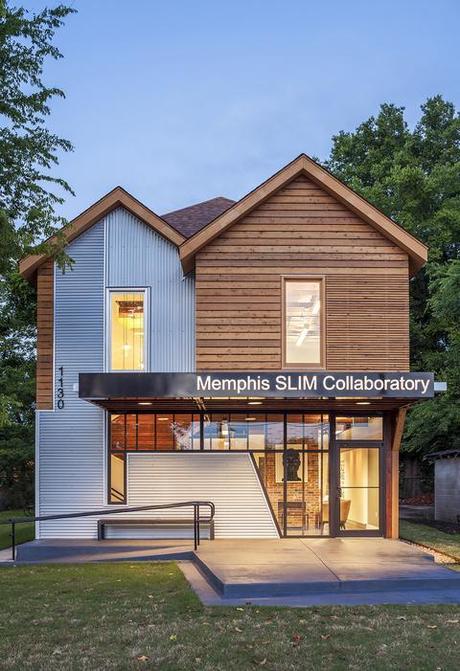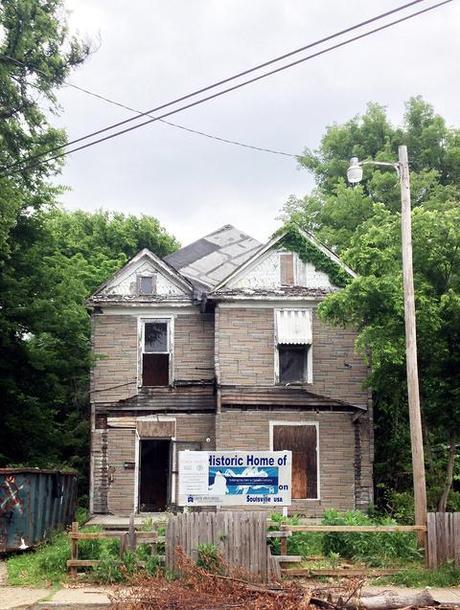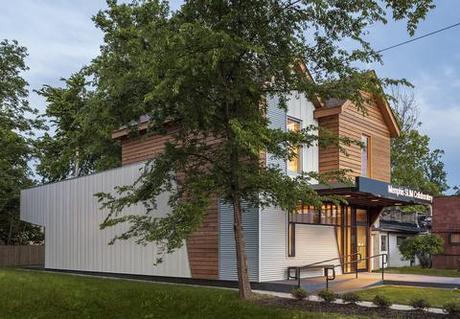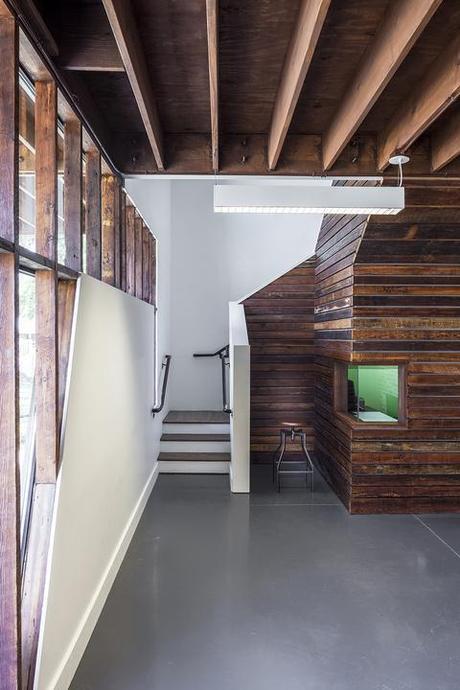
Architect Jason Jackson recast the Memphis, Tennessee, home of blues musician John Len Chatman into a music collaboratory—a place equipped for career counseling, recording, workshops, and community events.
For Soul musicians in the 1960s, the area of Memphis near Stax Records—the legendary studio that produced albums by Otis Redding, Isaac Hayes, and the Staples Singers, among others—was the place to be. Many of the people Stax represented lived in the area or were involved in the community; local music-oriented businesses, like the Satellite record shop, were popular hangouts. Stax eventually named the thriving neighborhood "Soulsville USA" (a riff on Motown's "Hitsville USA" moniker).
Slideshow
Before the Memphis Music Magnet Program's adaptive reuse project, John Len Chatman's house was decaying on its lot. Charlie Santo, head of the Memphis Music Magnet, has been working to revive the Soulsville neighborhood in which the house is situated by forging a creative hub tied to its cultural legacy. "In this city, the music community has always been as important as the music business, and music has often existed at the nexus of creativity, diversity, and place-making," Santo says. "Soulsville USA embodies that heritage and our work there seeks to build on existing arts assets in a neighborhood that is truly reflective of Memphis.”
In subsequent decades, the neighborhood fell into decline due to policy decisions—like the removal of a street-car line in the area—as well and shifts in the social fabric of the city. In the 1970s, Stax went bankrupt; in 1989 it was demolished. Today, the neighborhood still suffers from poverty and high unemployment levels. As a way to revitalize the neighborhood, planners and developers have tapped into its history, using music as a catalyst for reinvention.
The newly opened Memphis Slim Collaboratory is an element within a concept that originated in the University of Memphis's graduate program in city and regional planning that seeks to bring more creative energy back into the neighborhood. Rather than exist as some kind of generic urban renewal plan, the Memphis Music Magnet Plan instead seeks to spur growth that's directly tied to the hyperspecific heritage of a place.
Slideshow
The new design is clad in cedar and corrugated metal. The front porch is a key space as it "engages the street and creates a public space that everyone can take ownership of," Jackson says. "Simultaneously we opened up the front elevation to create views into the recording spaces from the exterior, welcoming in the community."
In the 1960s, knowledge spillover created by musicians bumping into each other and sharing ideas around Stax helped fuel the music scene. Through geographic proximity, the Memphis Music Magnet hopes to foster a similar creative environment today. "It’s about creating a neighborhood where music and art tell stories, activate spaces, reclaim vacant buildings, create interaction, and connect neighbors new and old,” says Charlie Santo, Head of the Memphis Music Magnet. "As cities shift from economies based on manufacturing products to economies based on producing ideas, their success depends on supporting creative people. Artists, musicians, and other creative have a significant impact on neighborhood revitalization and tend to play active roles in the community and address community problems."Memphis Slim's residence was one of the structures in the neighborhood that fell into a decaying state—the roof and floors were rotten and a tree fell on top of the house. Enter architect Jason Jackson of brg3sarchitects. Tasked with transforming the house into a rehersal space, recording studio, education center, and computer lab, he created a modern plan that pays homage to the original residence.
"As designers, if we can appreciate the community for what it is and celebrate those unique characteristics, we can enact much greater neighborhood change," Jackson says. "It’s about place making. Each neighborhood is unique, and embracing the character of the Soulsville neighborhood created a much greater impact on the surrounding houses and businesses than would have evolved had we tried to shoehorn in a design created in isolation."
Jackson's team met with the community to inform the design process. "Everyone agreed that because we were turning the house into a community-oriented recording studio-and not preserving the building as a house-that it needed to be designed as something new," Jackson says. "However, it was clear to us that the community felt strongly that it was important to reflect the original house in literal and abstract ways." To that end, the firm recreated the original two-story facade, retained the interior staircase, and hired ViktorHall Construction to salvage materials from the historic home. Wood framing became interior wall cladding, and bricks compose a new fireplace.
Slideshow
Wood salvaged from the original house covers the staircase. "It took a bit of effort to surgically deconstruct the house to save as much material as we could and clean it up for reuse," Jackson says. "I think it’s inspiring for the guests to the Collaboratory to know that the fireplace is in the exact same location, and consists of the original brick, as the original house, so that they can experience a space that’s still evocative of the home in which Memphis Slim lived." ViktorHall Construction carried out the deconstruction.
"A crucial piece to this project is the exterior stage," Jackson says. "This was the front porch where Memphis Slim could often be found playing Music with Isaac Hayes and Rufus Thomas. Most of the buildings in the area are very inwardly focused: residences with fences, small commercial shops with bars on their windows. The idea was to break out and activate the exterior and celebrate the neighborhood."For the recording studio, which projects from the rear of the house, Jackson selected cedar planks for the rain screen—a material that evoked the original structure's clapboard siding—and corrugated metal to reflect the new nature of the space and to tie it into other buildings in the area.
"The idea was to interweave these two forms and materials in a dynamic way that would transform the once home of Memphis Slim into this new community-oriented collaboratory," Jackson says. "When you’re trying to create something new and still be respectful to the elements of the past that can be a challenge. The Chatman family still frequents Memphis, and it was important to myself and the design team to ensure that they felt that the finished project was a fitting legacy for Memphis Slim."
